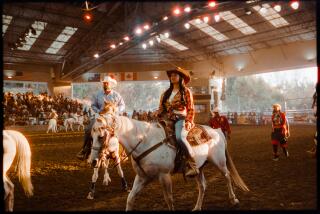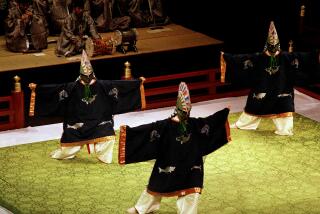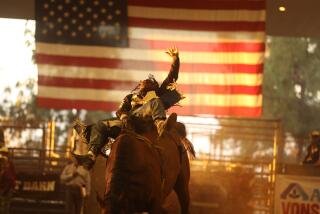Taking Poetic License : Cowboys to Read Their Prose at 3rd-Annual Festival
- Share via
SANTA CLARITA — The movies have been good to cowboys. Buckaroos like John Wayne never lied, cheated or stole--and loved their country to boot.
The movies have been good to Santa Clarita too. This city’s spare canyons have provided the lonesomely scenic backdrop to many a western shoot’em-up. The community named a park and high school after movie legend William S. Hart, who lived in Newhall from 1928 to 1946.
Now Santa Clarita hopes to create a poetic image, too, capitalizing on the cowboy mystique the community had a hand in creating.
Trying to rustle up a reputation for the Santa Clarita Valley that reaches beyond being known as the home of Six Flags Magic Mountain, the city will sponsor its third annual Cowboy Poetry & Music Festival next weekend, a three-day extravaganza replete with verse, ballads, trail rides, dance workshops and a cowboy gear show.
“Every city has softball and T-ball--there are a lot of traditional city things,” said Ken Pulskamp, the assistant city manager.
But a cowboy poetry festival-- that, he said, “is unique.”
Despite the event’s recent beginnings, Santa Clarita now hosts one of the nation’s biggest such festivals, second only to the oldest and most prestigious gathering, held in Elko, Nev., each January since 1985.
Santa Clarita’s festival has grown, in part, because many of the 150 or so cowboy poetry gatherings are barely promoted. Performers in Santa Clarita are paid pretty well as cowboy poetry events go--headliners can make several thousand dollars--which helps attract the best, says Hal Cannon, founding director of the Western Folklife Center in Elko, which organizes the festival there.
About 20 to 25 artists and thousands of spectators are expected in Santa Clarita.
But big bucks aren’t the point, says festival organizer Dianna Boone.
Cowboy values are about simplicity and love of the land, not cruel gunfighters or rhinestone glitz, she says.
“It gets us back to basics about what is important in our lives. You know, what is important is how we treat each other,” she said. “I think Americans love those values and are hungering to hear them again. It feeds our soul.”
City leaders like the idea that people who are refreshing their souls are spending money too. The first event pumped at least $244,000 into the local economy.
“It’s a good thing from the economic development point of view . . . to bring in people who can spend money and go away,” said Mike Haviland, the city’s marketing and economic development manager.
City leaders hope a reputation as a cowboy culture capital will attract jobs to the area by polishing the city’s image, which is indistinct because of the 8-year-old community’s relative youth and its lack of a dominating industry.
The festival also provides relief for those nostalgic for the not-so-old days. There aren’t that many ranches left now in Santa Clarita, where just 25 years ago ranching was a common lifestyle.
But the Santa Clarita community of Newhall still retains some of the cowboy style.
“This area has historically been a western-oriented town,” said Eric Leeser, manager of the Way Station Coffee Shop there. “Unfortunately, civilization has taken us over.”
The city’s spin-meisters say emphasis on the festival proves that even though Santa Clarita has yet to solidly define its image, it hasn’t forgotten its roots.
“We wanted to have a festival for people to give us a positive image,” Boone said. “But it’s not a wine festival. It’s something that ties us into our history. It’s important for us to remember from whence we came.”
The festival’s center is Melody Ranch, an Old West town re-created by Hollywood with a dusty main street, boardinghouse and hitching rails for the horses. Cowboy singing star Gene Autry once owned the ranch, and the buildings were the backdrop for classic Westerns such as “High Noon” and the television series “Gunsmoke.”
The Melody Ranch town is more than just movie false fronts. Many of the buildings are complete and usable. Inside the bar is a barroom.
But the festival is not about promoting John Wayne wannabes, nor about selling the latest CD from Nashville, Boone says.
The poets who show up to recite are often real cowboys, speaking about tough jobs on hard land. Their words are simple, their ideas clear. Stanzas rhyme, as this example from the anthology “Cowboy Poetry: A Gathering” attests.
“The Old Night Hawk,” by Bruce Kiskaddon
I used to shrink when I thought of the past
And some of the things I have known.
I took to drink, but now at last,
I’d far rather be alone.
It’s strange how quick a night goes by,
Fer I live in the days of old.
Up here where there’s only the hosses and I;
Up in the pinnacles bold.
Cannon, the anthology’s editor, said modern cowboy poetry is “not snobby, but it’s full of wisdom.”
More to Read
Sign up for our Book Club newsletter
Get the latest news, events and more from the Los Angeles Times Book Club, and help us get L.A. reading and talking.
You may occasionally receive promotional content from the Los Angeles Times.







